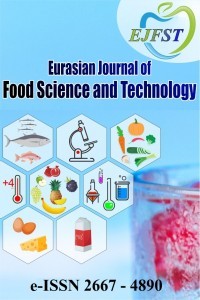Development of Locust Bean Fermentation Bin
Development of Locust Bean Fermentation Bin
ocust bean, sensory analysis, fermentation operation, fermentation bin,
___
- Akegbejo-Samsons Y. O. 2004. Chemical composition and binding power of dried pulp wastes produced from the African locust bean (Parkia Biglobosa) in low-cost fish diets. Ife Journal of Science, 6 (1): 30-34.
- B. Diawara L. S. 2000. HACCP System for traditional fermented food (sombala) capacity building for research and quality assurance and food fermentation technology for African fermented foods. WAITRO Journal, 11 – 62.
- Campbell – Platt G. 1980. African locust bean (Parkia species) and its West African fermented food product, Dawadawa. Ecology of Food and Nutrition, 9: 123-132.
- Dalziel J.M. 1937. The useful plants of west tropical Africa. Crown Agents, London.
- Gernah D. I., Inyang C.U. & Ezeoro N.L. 2006. Incubation and fermentation of African locustbean (parkia biglobosa) in production of “dawadawa” Journal of food processing and preservation 31 (2007) 227-239.
- Akande F. B., Adejumo O. A., Adamade C. A. & Bodunde J. 2010. Processing of locust bean fruits: Challenges and Prospects. African Journal of Agricultural Research Vol. 5(17), 2268-2271.
- Glasson Grain Ltd. 2006. Product Safety Datasheet.
- Ogunjimi L.A.O., Aviara N.A. & Aregbesola O. A. 2002. Some engineering properties of locust seed. a. Journal of food engineering. volume 55, issue 2, November 2002, pages 95-99.
- Odunfa S. A. 1981. Micro-organisms associated with fermentation of African locust bean during iru preparation. J. Plant Foods 3, 245–250.
- Oyewole O. B. & Odunfa S. A. 1990. Effects of cooking method on water absorption and ease of dehulling in the preparation of the African locust beans for Iru. Inter J of Food Sci and Tech 25(4):461–463.
- Leito R.C., Haandel A.C., Zeeman G. & Lettinga G. 2006. The effects of operational and environmental variations on anaerobic waste water treatment systems: A review. Bioresources Technology. 97(9):1105-11185.
- Sadiku O. 2010. Processing Methods Influence the Quality of Fermented Afric Locust Bean (iru/ogiri/dadawa) Parka biglobosa. J. Appl. Sci. 6, 1656-1661.
- Yayın Aralığı: Yılda 2 Sayı
- Başlangıç: 2017
- Yayıncı: İlknur BAĞDATLI
Effects of Climate Change on Aquaculture Production
Development of Locust Bean Fermentation Bin
Oluwagbotemi EDU, Philip OYENİYİ FAYOSE, Oseni KEHİNDE OWOLARAFE, Olumide FALANA
Environmentally Friendly Bacterial Cellulose Films for Food Packaging
Esin POYRAZOĞLU, Hacı Halil BIYIK, Öznur ÇETİN
Effects of Electrospinning on Antifungal Properties of Thyme and Cardamom Oils
Hilal Nur TEMİR, Funda KARBANCIOĞLU, Filiz ALTAY
John ADANSE, Kate BIGSON, Nkansah ASANTE MAUREEN, Agamba DOROTHY
Effects of Climate Change on Food Production
Özlem AYDIN BERKTAŞ, Fehmi ODABASOGLU, Fadime ATALAY DUMLU, Zerrin KUTLU, Elif ÇADIRCI, Mesut HALICI, Fazlı ÖZTÜRK, Ahmet ÇAKIR
Abdulkadir BELLO, Nura Isyaku BELLO, Kamaluddeen A. BABA, Ahmad SAİD ABUBAKAR
